Lyons W.C. (ed.). Standard handbook of petroleum and natural gas engineering.2001- Volume 1
Подождите немного. Документ загружается.

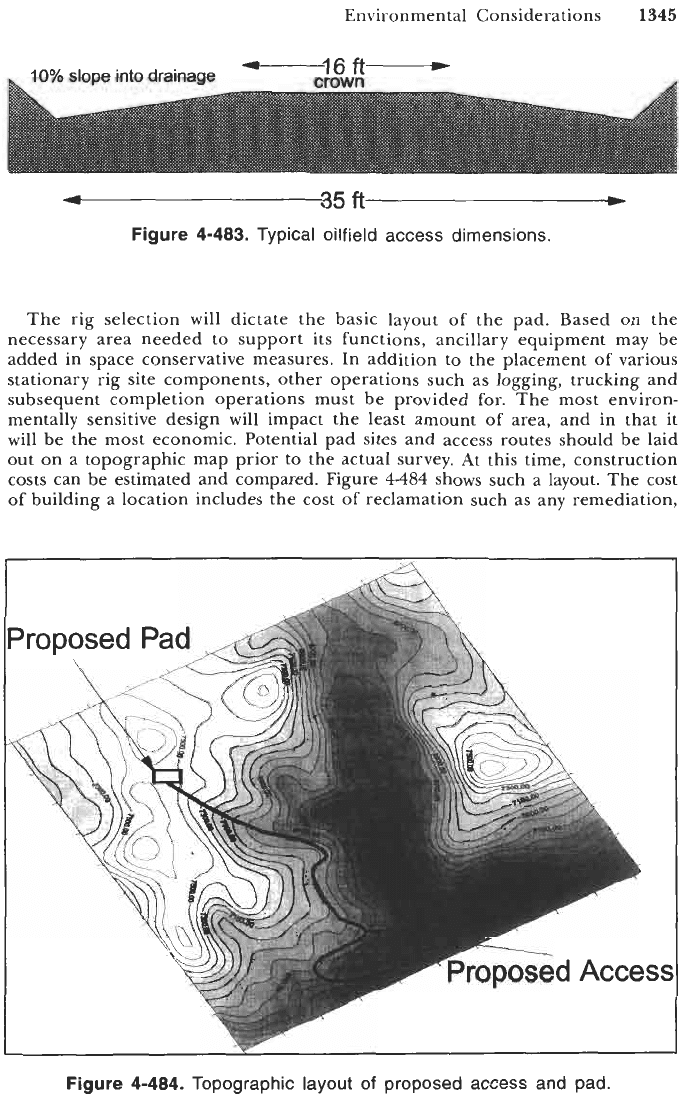
Environmental Considerations
1345
-16
ft-
10%
slope into drainage
crown
Figure
4-483.
Typical oilfield access dimensions.
The rig selection will dictate the basic layout of the pad. Based on the
necessary area needed to support its functions, ancillary equipment may be
added in space conservative measures. In addition to the placement of various
stationary rig site components, other operations such as logging, trucking and
subsequent completion operations must be provided for. The most environ-
mentally sensitive design will impact the least amount of area, and in that it
will be the most economic. Potential pad sites and access routes should be laid
out on a topographic map prior to the actuaI survey. At this time, construction
costs can be estimated and compared. Figure
4-484
shows such a layout. The cost
of building
a
location includes the cost of reclamation such as any remediation,
Figure
4-484.
Topographic layout of proposed access and pad.
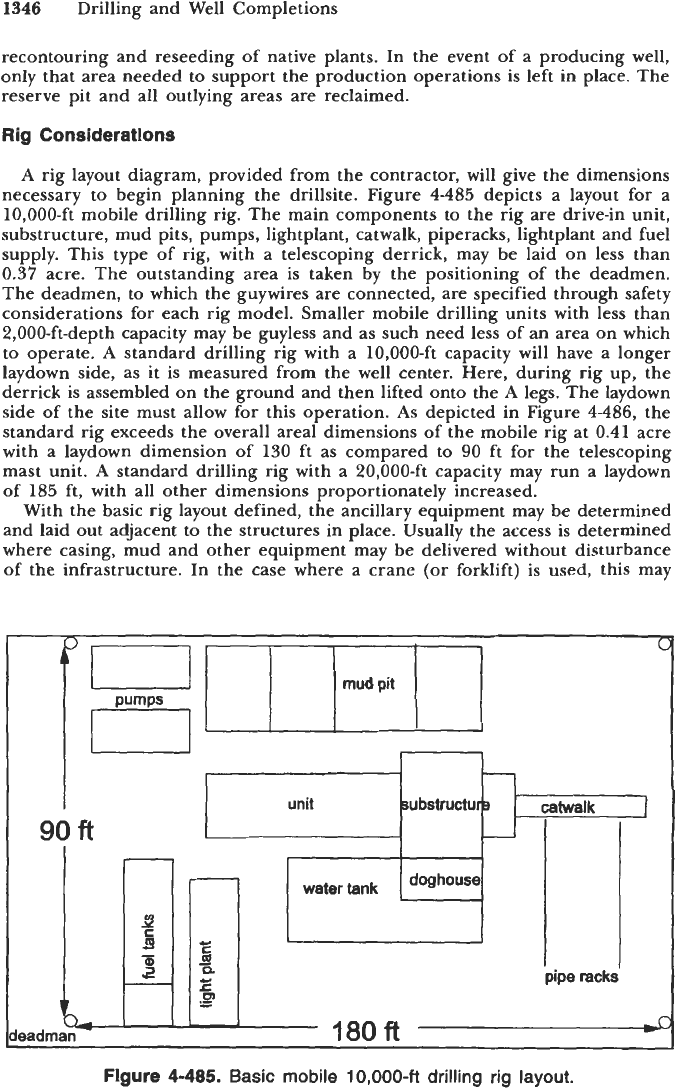
1346
Drilling and Well Completions
recontouring and reseeding
of
native plants. In the event of
a
producing well,
only that area needed to support the production operations is left in place. The
reserve pit and all outlying areas are reclaimed.
Rlg
Considerations
A
rig layout diagram, provided from the contractor, will give the dimensions
necessary to begin planning the drillsite. Figure
4-485
depicts
a
layout for a
10,000-ft mobile drilling rig. The main components to the rig
are
drive-in unit,
substructure, mud pits, pumps, lightplant, catwalk, piperacks, lightplant and fuel
supply. This
type
of
rig, with a telescoping derrick, may be laid on less than
0.37
acre. The outstanding area is taken by the positioning of the deadmen.
The deadmen, to which the guywires are connected, are specified through safety
considerations for each rig model. Smaller mobile drilling units with less than
2,000-ft-depth capacity may be guyless and as such need less of an area on which
to operate.
A
standard drilling rig with
a
10,000-ft capacity will have
a
longer
laydown side, as it is measured from the well center. Here, during rig up, the
derrick is assembled on the ground and then lifted onto the
A
legs. The laydown
side
of
the site must allow for this operation.
As
depicted in Figure
4-486,
the
standard rig exceeds the overall areal dimensions of the mobile rig at
0.41
acre
with a laydown dimension of
130
ft as compared to
90
ft for the telescoping
mast unit.
A
standard drilling rig with a 20,000-ft capacity may run a laydown
of
185
ft, with all other dimensions proportionately increased.
With the basic rig layout defined, the ancillary equipment may be determined
and laid out adjacent to the structures in place. Usually the access is determined
where casing, mud and other equipment may be delivered without disturbance
of the infrastructure.
In
the case where a crane (or forklift) is used, this may
i
90
ft
c
leadman
h,
180ft
Figure
4-485.
Basic
mobile
10,000-ft
drilling
rig
layout.

Environmental Considerations
1347
Dit side
t
I
rear
I,
.-
derrick
/
-
laydowr
doghouse
water
tank
side
zs
4
200
ft
w
Figure
4-486.
Basic layout for drilling rig with standard derrick.
mean a simple loop from the rear to the laydown on the working side of the
location.
A
loop is the optimum arrangement whereby multiple-truck interference
may be avoided. In the event a crane is not available, extra space is needed to
accommodate the activity of gin trucks positioning the materials. Figure
4-487
shows an overall location view.
Drllling Fluid Considerations
The drilling fluid program will define to some extent a major portion of the
pad including reserve pit, blow pit and equipment space. The program may
include a closed system
or
a conventional one. The fluids can be oil-base mud,
air,
foam, water
or
other media. While the basic rig layout considers most mud
drilling activities, it does not figure in mud storage, additional water storage,
or air drilling systems. The overall layout may even be reduced in some cases.
A
closed mud system
or
air drilling eliminates the requirement for a large
reserve pit.
Air Drilling.
In the event of air drilling, the blooie line will exit from under
the substructure and away from the rig. Depending on the nature of the payzone,
the blooie line will extend different lengths from the rig.
For
example,
a
well,
producing
20
MMcfd in addition to the injection of
2,000
cfm air, will require
an extension of at least
150
ft, due to heat and dust accumulation. The blow
pit with berm will often extend another
40
ft beyond that to include both the
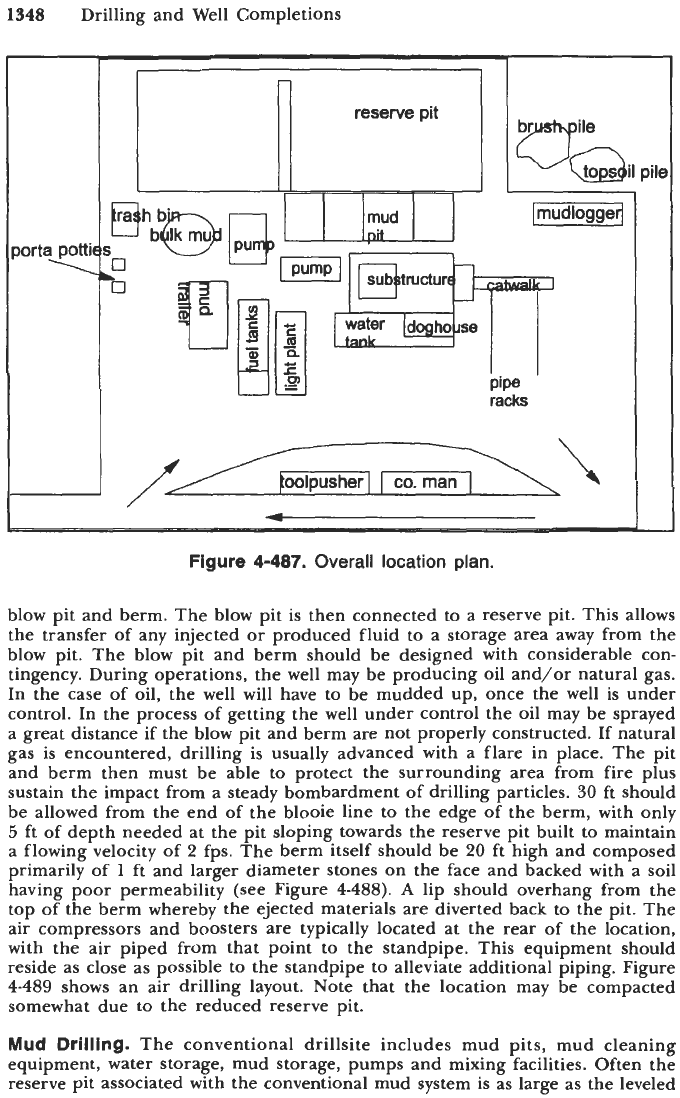
1348
Drilling and Well Completions
oolpusher
I
I
co. man
I
I
Figure
4-487.
Overall location plan.
blow pit and berm. The blow pit
is
then connected to a reserve pit. This allows
the transfer of any injected or produced fluid to a storage area away from the
blow pit. The blow pit and berm should be designed with considerable con-
tingency. During operations, the
well
may be producing oil and/or natural gas.
In the case of oil, the well will have to be mudded up, once the well is under
control. In the process of getting the well under control the oil may be sprayed
a great distance if the blow pit and berm are not properly constructed. If natural
gas is encountered, drilling is usually advanced with a flare in place. The pit
and berm then must be able to protect the surrounding area from fire plus
sustain the impact from a steady bombardment of drilling particles.
30
ft should
be allowed from the end of the blooie line to the edge of the berm, with only
5
ft of depth needed at the pit sloping towards the reserve pit built to maintain
a flowing velocity of
2
fps. The berm itself should be
20
ft high and composed
primarily of
1
ft and larger diameter stones on the face and backed with a soil
having poor permeability (see Figure
4-488).
A
lip should overhang from the
top of the berm whereby the ejected materials are diverted back to the pit. The
air compressors and boosters are typically located at the rear of the location,
with the air piped from that point to the standpipe. This equipment should
reside as close as possible to the standpipe to alleviate additional piping. Figure
4-489
shows an air drilling layout. Note that the location may be compacted
somewhat due to the reduced reserve pit.
Mud Drilling.
The conventional drillsite includes mud pits, mud cleaning
equipment, water storage, mud storage, pumps and mixing facilities. Often the
reserve pit associated with the conventional mud system is as large as the leveled
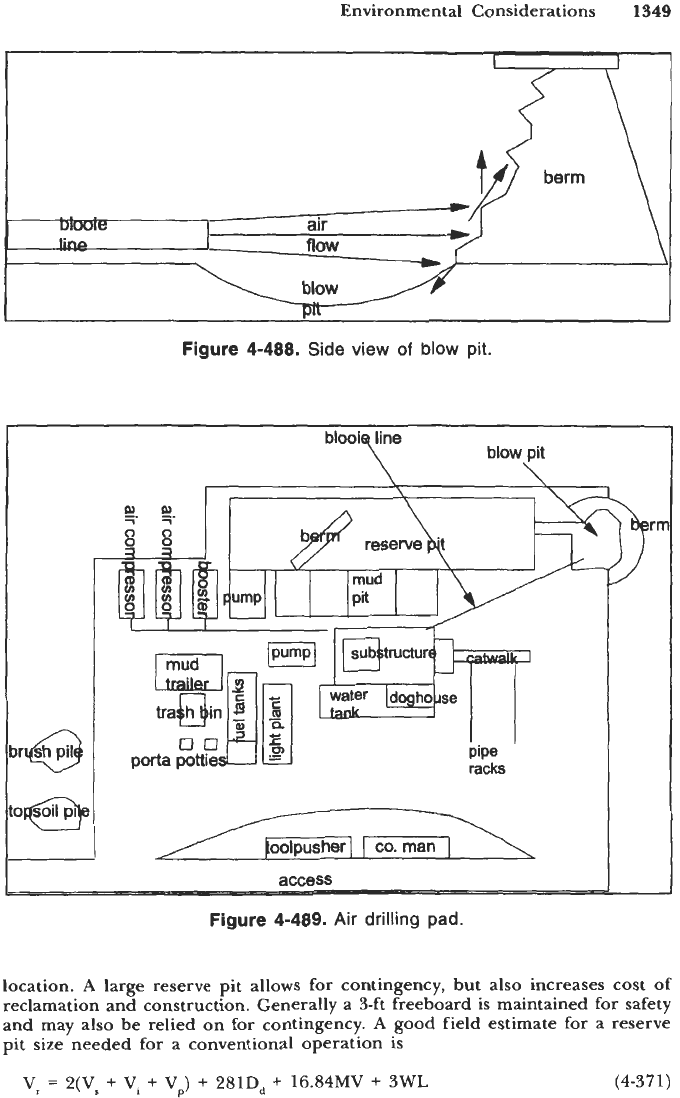
Environmental Considerations
1549
I
Figure 4-488.
Side
view
of
blow
pit.
blooiT
blow
-.
pit
toe
\
a,m
lr
-.
-.
I
1
toolpusher
I
I
co.
man
I
access
If-
/
Figure 4-489.
Air drilling pad.
location.
A
large reserve pit allows for contingency, but also increases
cost
of
reclamation and construction. Generally a 3-ft freeboard is maintained for safety
and may also be relied on for contingency.
A
good
field estimate for a reserve
pit size needed for a conventional operation
is
Vr
=
2(Vs
+
Vi
+
Vp)
+
281D,
+
16.84MV
+
3WL
(4-37
1)
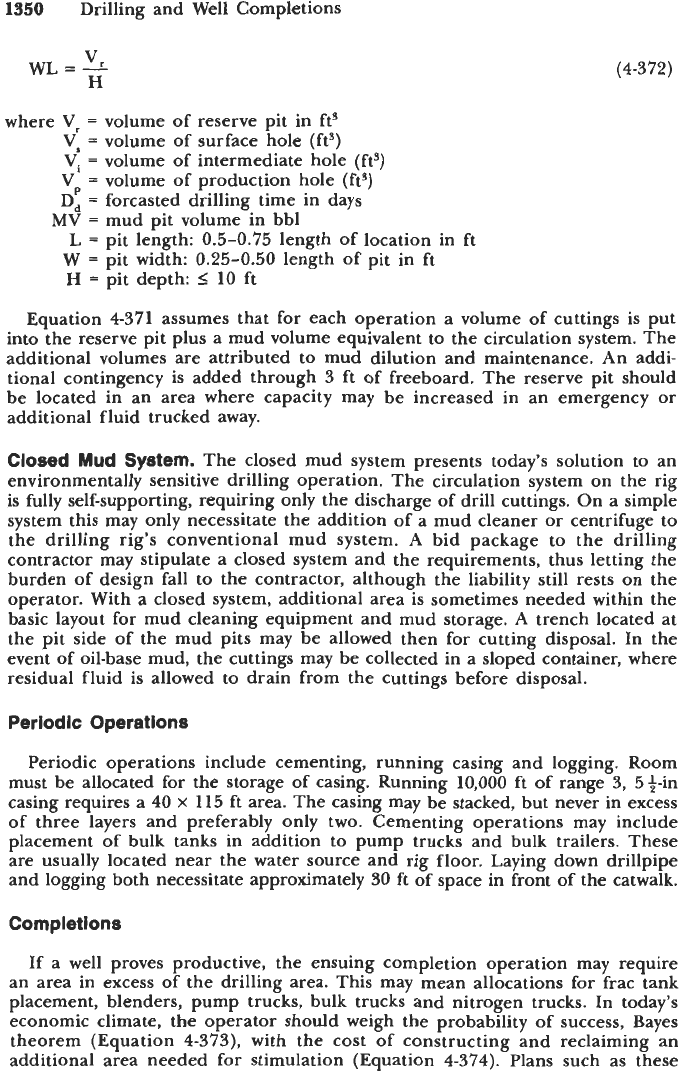
1350
Drilling and Well Completions
(4-372)
where
Vr
=
volume of reserve pit in ft’
Vs
=
volume of surface hole (ft3)
Vi
=
volume of intermediate hole (ft3)
V,
=
volume of production hole (ft5)
D,
=
forcasted drilling time in days
MV
=
mud pit volume in bbl
L
=
pit length:
0.5-0.75
length of location in ft
W
=
pit width:
0.25-0.50
length of pit in ft
H
=
pit depth:
S
10
ft
Equation
4-371
assumes that for each operation a volume of cuttings is put
into the reserve pit plus a mud volume equivalent to
the
circulation system. The
additional volumes are attributed to mud dilution and maintenance. An addi-
tional contingency is added through
3
ft of freeboard. The reserve pit should
be located in an area where capacity may be increased in an emergency or
additional fluid trucked away.
Closed
Mud
System.
The closed mud system presents today’s solution to an
environmentally sensitive drilling operation. The circulation system on the rig
is fully self-supporting, requiring only the discharge of drill cuttings. On a simple
system this may only necessitate the addition
of
a
mud cleaner
or
centrifuge to
the drilling rig’s conventional mud system.
A
bid package to the drilling
contractor may stipulate a closed system and the requirements, thus letting the
burden of design fall to the contractor, although the liability still rests on the
operator. With
a
closed system, additional area is sometimes needed within the
basic layout
for
mud cleaning equipment and mud storage.
A
trench located at
the pit side of the mud pits may be allowed then for cutting disposal. In the
event of oil-base mud, the cuttings may be collected in a sloped container, where
residual fluid is allowed to drain from the cuttings before disposal.
Periodlc Operations
Periodic operations include cementing, running casing and logging. Room
must be allocated for the storage of casing. Running
10,000
ft of range
3,
54-in
casing requires a
40
x
115
ft
area. The casing may be stacked, but never in excess
of three layers and preferably only two. Cementing operations may include
placement of bulk tanks in addition
to
pump trucks and bulk trailers. These
are usually located near the water source and rig floor. Laying down drillpipe
and logging both necessitate approximately
30
ft of space in front of the catwalk.
Completlons
If
a well proves productive, the ensuing completion operation may require
an area in excess of the drilling area. This may mean allocations for frac tank
placement, blenders, pump trucks, bulk trucks and nitrogen trucks. In today’s
economic climate, the operator should weigh the probability of success, Bayes
theorem (Equation
4-373),
with the cost of constructing and reclaiming an
additional area needed for stimulation (Equation
4-374).
Plans such as these
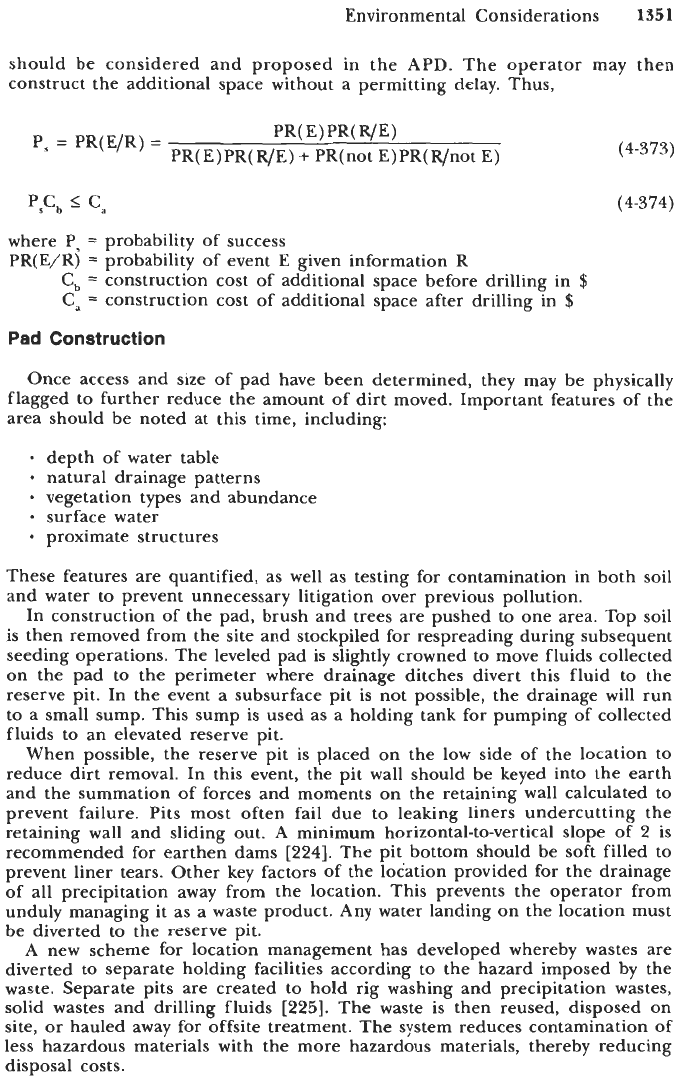
Environmental Considerations
135
1
should be considered and proposed in the APD. The operator may then
construct the additional space without a permitting delay. Thus,
P,
=
PR(E/R)
=
PR(E)PR(R/E)
PR(
E)PR( YE)
+
PR(not E)PR( wnot E)
(4-373)
(4-374)
where Ps
=
probability of success
PR(E/R)
=
probability of event E given information
R
C,
=
construction cost of additional space before drilling in
$
Ca
=
construction cost of additional space after drilling in
$
Pad
Construction
Once access and size of pad have been determined, they may be physically
flagged to further reduce the amount of dirt moved. Important features of the
area should be noted at this time, including:
depth of water table
natural drainage patterns
vegetation types and abundance
proximate structures
surface water
These features are quantified, as well as testing for contamination in both soil
and water to prevent unnecessary litigation over previous pollution.
In construction of the pad, brush and trees are pushed to one area. Top soil
is then removed from the site and stockpiled for respreading during subsequent
seeding operations. The leveled pad is slightly crowned to move fluids collected
on the pad
to
the perimeter where drainage ditches divert this fluid to the
reserve pit. In the event
a
subsurface pit is not possible, the drainage will run
to a small sump. This sump is used as a holding tank for pumping of collected
fluids to an elevated reserve pit.
When possible, the reserve pit is placed on the low side of the location to
reduce dirt removal. In this event, the pit wall should be keyed into the earth
and the summation of forces and moments on the retaining wall calculated to
prevent failure. Pits most often fail due to leaking liners undercutting the
retaining wall and sliding out. A minimum horizontal-to-vertical slope of
‘2
is
recommended for earthen dams
[224].
The pit bottom should be soft filled to
prevent liner tears. Other key factors of the location provided for the drainage
of all precipitation away from the location. This prevents the operator from
unduly managing it as a waste product. Any water landing on the location must
be diverted
to
the reserve pit.
A
new scheme for location management has developed whereby wastes are
diverted to separate holding facilities according to the hazard imposed by the
waste. Separate pits are created to hold rig washing and precipitation wastes,
solid wastes and drilling fluids
[225].
The waste is then reused, disposed on
site, or hauled away
for
offsite treatment. The system reduces contamination of
less hazardous materials with the more hazardous materials, thereby reducing
disposal costs.
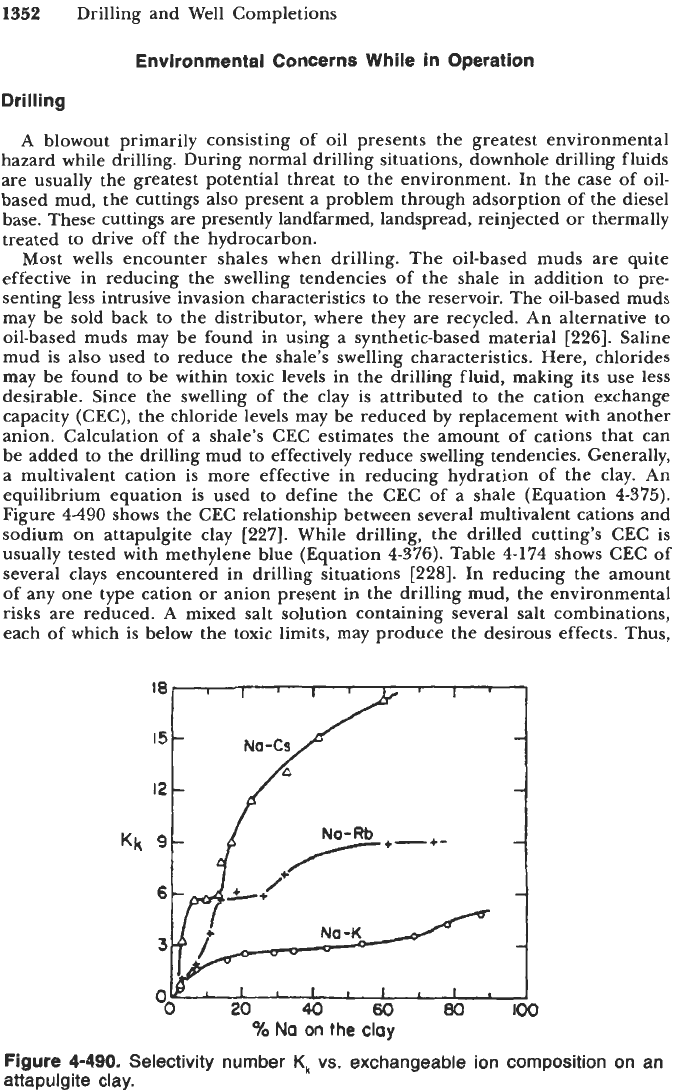
1352
Drilling and Well Completions
Environmental Concerns While in Operation
Drilling
A blowout primarily consisting of oil presents the greatest environmental
hazard while drilling. During normal drilling situations, downhole drilling fluids
are usually the greatest potential threat to the environment. In the case of oil-
based mud, the cuttings also present a problem through adsorption of the diesel
base. These cuttings are presently landfarmed, landspread, reinjected
or
thermally
treated to drive off the hydrocarbon.
Most wells encounter shales when drilling. The oil-based muds are quite
effective in reducing the swelling tendencies of the shale in addition to pre-
senting less intrusive invasion characteristics to the reservoir. The oil-based muds
may be sold back to the distributor, where they are recycled. An alternative to
oil-based muds may be found in using a synthetic-based material
[226].
Saline
mud is also used to reduce the shale’s swelling characteristics. Here, chlorides
may be found to be within toxic levels in the drilling fluid, making its use less
desirable. Since the swelling of the clay is attributed to the cation exchange
capacity
(CEC),
the chloride levels may
be
reduced by replacement with another
anion. Calculation of a shale’s CEC estimates the amount of cations that can
be added to the drilling mud to effectively reduce swelling tendencies. Generally,
a multivalent cation is more effective in reducing hydration of the clay. An
equilibrium equation
is
used to define the CEC of a shale (Equation
4-375).
Figure
4490
shows the CEC relationship between several multivalent cations and
sodium on attapulgite clay
[227].
While drilling, the drilled cutting’s CEC is
usually tested with methylene blue (Equation
4-376).
Table
4-174
shows CEC of
several clays encountered in drilling situations
[228].
In reducing the amount
of any one type cation
or
anion present in the drilling mud, the environmental
risks are reduced.
A
mixed salt solution containing several salt combinations,
each of which is below the toxic limits, may produce the desirous effects. Thus,
Na-Cs
%
Na
on
the
clay
Flgure
4-490.
Selectivity number
K,
vs. exchangeable ion composition
on
an
attapulgite clay.

Environmental Considerations
1353
Table
4-174
Cation Exchange Capacity
of
Various Materials
Encountered in Drilling
[225].
Material meq/lOO g-moisture
free
Wyoming Bentonite
Soft
Shale
Kaolinite
Drilled Cuttings
75
45
10
8
(4-375)
where NaX
=
sodium on the shale in meq
c
=
charge of multivalent cation
M
=
multivalent cation in meq
(4-376)
where MBC
=
methylene blue capacity in meq/100 g
MB
=
methylene blue in meq
MShale
=
weight of shale in
100
g
There are a variety of chemicals that are toxic and used in the drilling fluid
makeup. Chromates and asbestos were once commonly used and are now off the
market. A mud inventory should be kept for all drilling additives. Included in the
inventory are the material safety data sheets
(MSDS)
that describe each material's
pertinent characteristics. The chemicals found on the
MSDS
sheet should be
compared with the priority pollutants and any material should be eliminated
if
a
match is found. The chemicals should also be checked on arrival for breakage and
returned to the vendor if defective packaging is found. All mud additives should
be housed in a dry area and properly cared for to prevent waste. Chemicals should
always be mixed in packaged proportions. Wasted chemicals, ejected to the reserve
pit by untrained personnel, can present future liabilities to the operator.
Rig Practice.
All drilling fluids should be contained in the mud pits or reserve
pit. The cellar should have a conduit linking it to the reserve pit such that
accumulation of mud from connections does not spread over the location. In
the case of toxic mud, a bell should be located beneath the rotary table to direct
such fluids back into the drilling nipple or into the mud pit in the case of a
rotating head. The use of a mud bucket is also recommended in situations where
the pipe can not be
shook
dry.
Many operators are now requiring that absorbent or catch pans be placed
beneath the drilling rig. Oil and grease leaks/spillage are common to the drilling
rig operation. Even if the drilling rig is new, leaks and spills are inevitable. Fuel
and oil racks should provide a spill-resistant pour device for direct placement
of the lubricant/fuel into equipment. Oil changed on location must be caught
in barrels and recycled by the contractor. Pipe dope should be environ-mentally
sound and not a metal type. Thread cleaning on casing is now frequently done
with machines that catch the solvent for reuse on subsequent operations.
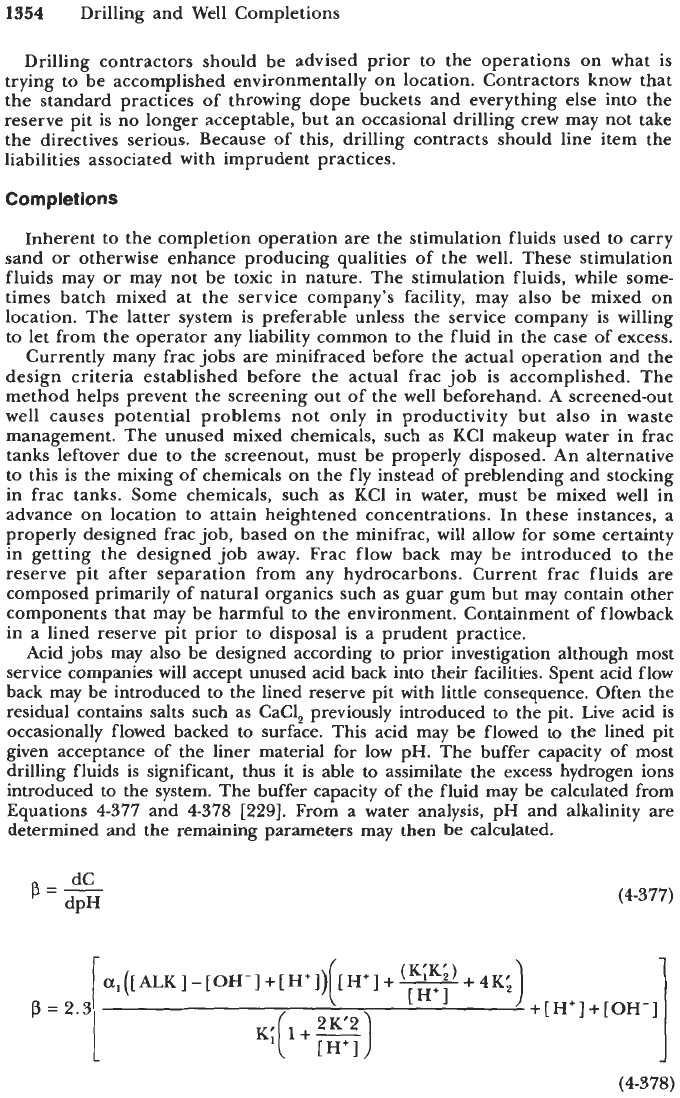
1354
Drilling and Well Completions
Drilling contractors should be advised prior to the operations on what is
trying
to
be accomplished environmentally on location. Contractors know that
the standard practices of throwing dope buckets and everything else into the
reserve pit is
no
longer acceptable, but an occasional drilling crew may not take
the directives serious. Because of this, drilling contracts should line item the
liabilities associated with imprudent practices.
Completions
Inherent
to
the completion operation
are
the stimulation fluids used to carry
sand or otherwise enhance producing qualities of the well. These stimulation
fluids may or may not be toxic in nature. The stimulation fluids, while some-
times batch mixed at the service company's facility, may also be mixed on
location. The latter system is preferable unless the service company is willing
to let from the operator any liability common to the fluid in the case of excess.
Currently many frac jobs are minifraced before the actual operation and the
design criteria established before the actual frac job is accomplished. The
method helps prevent the screening out of the well beforehand.
A
screened-out
well
causes potential problems not only in productivity but also in waste
management. The unused mixed chemicals, such as KCl makeup water in frac
tanks leftover due to the screenout, must be properly disposed. An alternative
to this is the mixing of chemicals on the
fly
instead of preblending and stocking
in frac tanks. Some chemicals, such as KCl in water, must be mixed well in
advance
on
location to attain heightened concentrations. In these instances, a
properly designed frac job, based on the minifrac, will allow for some certainty
in getting the designed job away. Frac flow back may be introduced to the
reserve pit after separation from any hydrocarbons. Current frac fluids are
composed primarily of natural organics such as guar gum but may contain other
components that may be harmful to the environment. Containment of flowback
in a lined reserve pit prior to disposal is a prudent practice.
Acid jobs may also be designed according to prior investigation although most
service companies will accept unused acid back into their facilities. Spent acid flow
back may be introduced to the lined reserve pit with little consequence. Often the
residual contains salts such as CaCl, previousIy introduced to the pit. Live acid is
occasionally flowed backed to surface. This acid may be flowed to the lined pit
given acceptance of the liner material for low pH. The buffer capacity of most
drilling fluids is significant, thus
it
is able to assimilate the excess hydrogen ions
introduced to the system. The buffer capacity of the fluid may be calculated from
Equations
4-377
and
4378
[229].
From a water analysis, pH and alkalinity
are
determined
and
the remaining parameters
may
then be calculated.
(4-377)
1
a,
([ALK]
-
[OH-]
+
[H+])(
[IT]
+
2
(K'K')
+
4K;
(
;:::)
[H'I )+[H+]+[OH-]
K;
I+-
p
=
2.3
(4-378)
